Molecule Information
General Information of the Molecule (ID: Mol00701)
| Name |
Wee1-like protein kinase (WEE1)
,Homo sapiens
|
||||
|---|---|---|---|---|---|
| Synonyms |
WEE1hu; Wee1A kinase
Click to Show/Hide
|
||||
| Molecule Type |
Protein
|
||||
| Gene Name |
WEE1
|
||||
| Gene ID | |||||
| Location |
chr11:9573670-9593457[+]
|
||||
| Sequence |
MSFLSRQQPPPPRRAGAACTLRQKLIFSPCSDCEEEEEEEEEEGSGHSTGEDSAFQEPDS
PLPPARSPTEPGPERRRSPGPAPGSPGELEEDLLLPGACPGADEAGGGAEGDSWEEEGFG SSSPVKSPAAPYFLGSSFSPVRCGGPGDASPRGCGARRAGEGRRSPRPDHPGTPPHKTFR KLRLFDTPHTPKSLLSKARGIDSSSVKLRGSSLFMDTEKSGKREFDVRQTPQVNINPFTP DSLLLHSSGQCRRRKRTYWNDSCGEDMEASDYELEDETRPAKRITITESNMKSRYTTEFH ELEKIGSGEFGSVFKCVKRLDGCIYAIKRSKKPLAGSVDEQNALREVYAHAVLGQHSHVV RYFSAWAEDDHMLIQNEYCNGGSLADAISENYRIMSYFKEAELKDLLLQVGRGLRYIHSM SLVHMDIKPSNIFISRTSIPNAASEEGDEDDWASNKVMFKIGDLGHVTRISSPQVEEGDS RFLANEVLQENYTHLPKADIFALALTVVCAAGAEPLPRNGDQWHEIRQGRLPRIPQVLSQ EFTELLKVMIHPDPERRPSAMALVKHSVLLSASRKSAEQLRIELNAEKFKNSLLQKELKK AQMAKAAAEERALFTDRMATRSTTQSNRTSRLIGKKMNRSVSLTIY Click to Show/Hide
|
||||
| Function |
Acts as a negative regulator of entry into mitosis (G2 to M transition) by protecting the nucleus from cytoplasmically activated cyclin B1-complexed CDK1 before the onset of mitosis by mediating phosphorylation of CDK1 on 'Tyr-15'. Specifically phosphorylates and inactivates cyclin B1-complexed CDK1 reaching a maximum during G2 phase and a minimum as cells enter M phase. Phosphorylation of cyclin B1-CDK1 occurs exclusively on 'Tyr-15' and phosphorylation of monomeric CDK1 does not occur. Its activity increases during S and G2 phases and decreases at M phase when it is hyperphosphorylated. A correlated decrease in protein level occurs at M/G1 phase, probably due to its degradation.
Click to Show/Hide
|
||||
| Uniprot ID | |||||
| Ensembl ID | |||||
| HGNC ID | |||||
| Click to Show/Hide the Complete Species Lineage | |||||
Type(s) of Resistant Mechanism of This Molecule
Drug Resistance Data Categorized by Drug
Approved Drug(s)
7 drug(s) in total
| Drug Sensitivity Data Categorized by Their Corresponding Mechanisms | ||||
|
|
||||
| Disease Class: Epidermoid carcinoma | [1] | |||
| Sensitive Disease | Epidermoid carcinoma [ICD-11: 2C31.Z] | |||
| Sensitive Drug | Cisplatin | |||
| Molecule Alteration | Expression | Down-regulation |
||
| Experimental Note | Revealed Based on the Cell Line Data | |||
| Cell Pathway Regulation | Cell apoptosis | Activation | hsa04210 | |
| In Vitro Model | KB-3-1 cells | Lung | Homo sapiens (Human) | CVCL_2088 |
| KB-CP.5 cells | Lung | Homo sapiens (Human) | CVCL_IP04 | |
| KB-CP20 cells | Lung | Homo sapiens (Human) | CVCL_IP06 | |
| Experiment for Molecule Alteration |
Western blotting analysis | |||
| Experiment for Drug Resistance |
MTT assay | |||
| Mechanism Description | Overexpression of the cell cycle kinases WEE1 and CHk1 occurred commonly in cisplatin-resistant cells, miR-15/16/195/424/497 family sensitize cisplatin-resistant cells to apoptosis by targeting WEE1 and CHk1. | |||
| Drug Resistance Data Categorized by Their Corresponding Mechanisms | ||||
|
|
||||
| Disease Class: Colon cancer | [2] | |||
| Resistant Disease | Colon cancer [ICD-11: 2B90.1] | |||
| Resistant Drug | Fluorouracil | |||
| Molecule Alteration | Expression | Up-regulation |
||
| Experimental Note | Revealed Based on the Cell Line Data | |||
| In Vitro Model | HCT116 cells | Colon | Homo sapiens (Human) | CVCL_0291 |
| Experiment for Molecule Alteration |
Western blot analysis | |||
| Experiment for Drug Resistance |
MTT assay; Flow cytometric analysis | |||
| Mechanism Description | Inhibition of miR195 sensitized resistant cells to 5-FU by downregulating WEE1 and CHk1. | |||
| Drug Sensitivity Data Categorized by Their Corresponding Mechanisms | ||||
|
|
||||
| Disease Class: Kidney cancer | [3] | |||
| Sensitive Disease | Kidney cancer [ICD-11: 2C90.1] | |||
| Sensitive Drug | Fluorouracil | |||
| Molecule Alteration | Expression | Down-regulation |
||
| Experimental Note | Revealed Based on the Cell Line Data | |||
| Cell Pathway Regulation | Cell apoptosis | Activation | hsa04210 | |
| Cell proliferation | Inhibition | hsa05200 | ||
| WEE1/Cdc2 signaling pathway | Activation | hsa04110 | ||
| In Vitro Model | 786-O cells | Kidney | Homo sapiens (Human) | CVCL_1051 |
| HK-2 cells | Kidney | Homo sapiens (Human) | CVCL_0302 | |
| Experiment for Molecule Alteration |
Western blotting analysis | |||
| Experiment for Drug Resistance |
MTT assay | |||
| Mechanism Description | miR-381 increases sensitivity of 786-O cells to 5-FU by inhibitory WEE1 and increase of Cdc2activity. | |||
| Drug Resistance Data Categorized by Their Corresponding Mechanisms | ||||
|
|
||||
| Disease Class: Breast cancer | [4] | |||
| Resistant Disease | Breast cancer [ICD-11: 2C60.3] | |||
| Resistant Drug | LY2835219 | |||
| Molecule Alteration | Expression | Up-regulation |
||
| Experimental Note | Revealed Based on the Cell Line Data | |||
| Mechanism Description | WEE1 plays an important role in the G2/M checkpoint. It inhibits the entry of DNA-damaged cells into mitosis in coordination with CDK1. Though the involvement of WEE1 in inducing resistance to CDK4/6 inhibitors is unknown, inhibition of WEE1 has been shown to increase sensitivity to CDK4/6 inhibitors in resistant cells. As WEE1 is associated with a resistant phenotype in preclinical models, targeting the G2/M phase via the inhibition of WEE1 in combination with CDK4/6 inhibition could be a therapeutic option in overcoming resistance. | |||
| Drug Resistance Data Categorized by Their Corresponding Mechanisms | ||||
|
|
||||
| Disease Class: Breast cancer | [4] | |||
| Resistant Disease | Breast cancer [ICD-11: 2C60.3] | |||
| Resistant Drug | Palbociclib | |||
| Molecule Alteration | Expression | Up-regulation |
||
| Experimental Note | Revealed Based on the Cell Line Data | |||
| Mechanism Description | WEE1 plays an important role in the G2/M checkpoint. It inhibits the entry of DNA-damaged cells into mitosis in coordination with CDK1. Though the involvement of WEE1 in inducing resistance to CDK4/6 inhibitors is unknown, inhibition of WEE1 has been shown to increase sensitivity to CDK4/6 inhibitors in resistant cells. As WEE1 is associated with a resistant phenotype in preclinical models, targeting the G2/M phase via the inhibition of WEE1 in combination with CDK4/6 inhibition could be a therapeutic option in overcoming resistance. | |||
| Drug Resistance Data Categorized by Their Corresponding Mechanisms | ||||
|
|
||||
| Disease Class: Breast cancer | [4] | |||
| Resistant Disease | Breast cancer [ICD-11: 2C60.3] | |||
| Resistant Drug | Ribociclib | |||
| Molecule Alteration | Expression | Up-regulation |
||
| Experimental Note | Revealed Based on the Cell Line Data | |||
| Mechanism Description | WEE1 plays an important role in the G2/M checkpoint. It inhibits the entry of DNA-damaged cells into mitosis in coordination with CDK1. Though the involvement of WEE1 in inducing resistance to CDK4/6 inhibitors is unknown, inhibition of WEE1 has been shown to increase sensitivity to CDK4/6 inhibitors in resistant cells. As WEE1 is associated with a resistant phenotype in preclinical models, targeting the G2/M phase via the inhibition of WEE1 in combination with CDK4/6 inhibition could be a therapeutic option in overcoming resistance. | |||
| Drug Sensitivity Data Categorized by Their Corresponding Mechanisms | ||||
|
|
||||
| Disease Class: Glioma | [5] | |||
| Sensitive Disease | Glioma [ICD-11: 2A00.1] | |||
| Sensitive Drug | Temozolomide | |||
| Molecule Alteration | Expression | Down-regulation |
||
| Experimental Note | Revealed Based on the Cell Line Data | |||
| In Vitro Model | SNB19 cells | Brain | Homo sapiens (Human) | CVCL_0535 |
| T98G cells | Brain | Homo sapiens (Human) | CVCL_0556 | |
| SNB19 TR cells | Brain | Homo sapiens (Human) | CVCL_0535 | |
| T98G TR cells | Brain | Homo sapiens (Human) | CVCL_0556 | |
| Experiment for Molecule Alteration |
Western blot analysis | |||
| Experiment for Drug Resistance |
MTT Assay; Wound healing assay; Transwell invasion assays | |||
| Mechanism Description | miR26b reverses temozolomide resistance via targeting Wee1 in glioma cells. miR26b governed TR-mediate EMT partly due to governing its target Wee1. | |||
| Drug Resistance Data Categorized by Their Corresponding Mechanisms | ||||
|
|
||||
| Disease Class: Diffuse large B-cell lymphoma | [6] | |||
| Resistant Disease | Diffuse large B-cell lymphoma [ICD-11: 2A81.0] | |||
| Resistant Drug | Vincristine | |||
| Molecule Alteration | Expression | Up-regulation |
||
| Experimental Note | Identified from the Human Clinical Data | |||
| In Vitro Model | OCI-Ly7 cells | N.A. | Homo sapiens (Human) | CVCL_1881 |
| SU-DHL-5 cells | N.A. | Homo sapiens (Human) | CVCL_1735 | |
| Experiment for Molecule Alteration |
Western blot analysis | |||
| Experiment for Drug Resistance |
Dose-response assays | |||
| Mechanism Description | Down-regulation of miR-155 promotes vincristine resistance via upregulating Week1. | |||
Investigative Drug(s)
1 drug(s) in total
| Drug Sensitivity Data Categorized by Their Corresponding Mechanisms | ||||
|
|
||||
| Disease Class: Acute T-cell lymphocytic leukemia | [7] | |||
| Sensitive Disease | Acute T-cell lymphocytic leukemia [ICD-11: 2A90.5] | |||
| Sensitive Drug | MK1775 | |||
| Molecule Alteration | Expression | Down-regulation |
||
| Experimental Note | Identified from the Human Clinical Data | |||
| In Vitro Model | Jurkat cells | Pleural effusion | Homo sapiens (Human) | CVCL_0065 |
| CCRF-CEM cells | Pleural effusion | Homo sapiens (Human) | CVCL_0207 | |
| MOLT4 cells | Bone marrow | Homo sapiens (Human) | CVCL_0013 | |
| DND41 cells | Pleural effusion | Homo sapiens (Human) | CVCL_2022 | |
| HPB-ALL cells | Peripheral blood | Homo sapiens (Human) | CVCL_1820 | |
| CUTLL1 cells | Pleural effusion | Homo sapiens (Human) | CVCL_4966 | |
| KOPTK1 cells | N.A. | Homo sapiens (Human) | CVCL_4965 | |
| In Vivo Model | NOD-Prkdcscid IL2Rgamma null NPG mice model | Mus musculus | ||
| Experiment for Molecule Alteration |
Western blotting assay | |||
| Experiment for Drug Resistance |
CCK8 assay | |||
| Mechanism Description | WEE1 inhibition sensitizes T-cell acute lymphoblastic leukemia cells to glutaminolysis inhibition.Elevated WEE1 expression driven by MYC poses the possibility that T-ALL cells may be particularly dependent on WEE1 for cell proliferation and survival. Indeed, a selective WEE1 inhibitor MK1775 as a single agent reduced cell viability in a dose-dependent manner in seven T-ALL cell lines, whereas the effect on normal BM cells was minimal. | |||
Disease- and Tissue-specific Abundances of This Molecule
ICD Disease Classification 02

| Differential expression of molecule in resistant diseases | ||
| The Studied Tissue | Nervous tissue | |
| The Specified Disease | Brain cancer | |
| The Expression Level of Disease Section Compare with the Healthy Individual Tissue | p-value: 0.00E+00; Fold-change: 2.69E+00; Z-score: 4.79E+00 | |
|
Molecule expression in the diseased tissue of patients
Molecule expression in the normal tissue of healthy individuals
|
||
| Disease-specific Molecule Abundances |
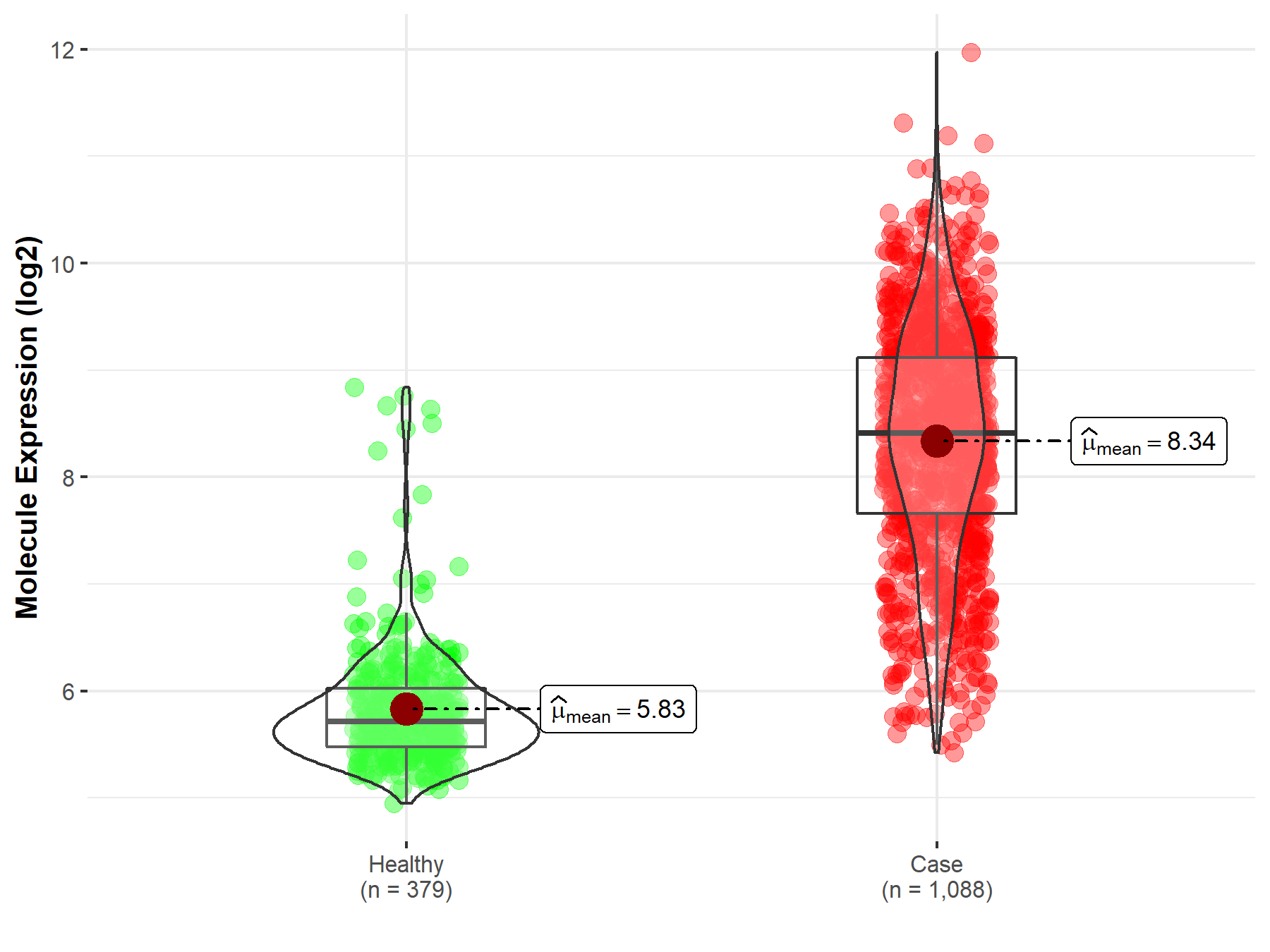
|
Click to View the Clearer Original Diagram |
| The Studied Tissue | Brainstem tissue | |
| The Specified Disease | Glioma | |
| The Expression Level of Disease Section Compare with the Healthy Individual Tissue | p-value: 9.26E-02; Fold-change: 1.51E+00; Z-score: 3.26E+00 | |
|
Molecule expression in the diseased tissue of patients
Molecule expression in the normal tissue of healthy individuals
|
||
| Disease-specific Molecule Abundances |
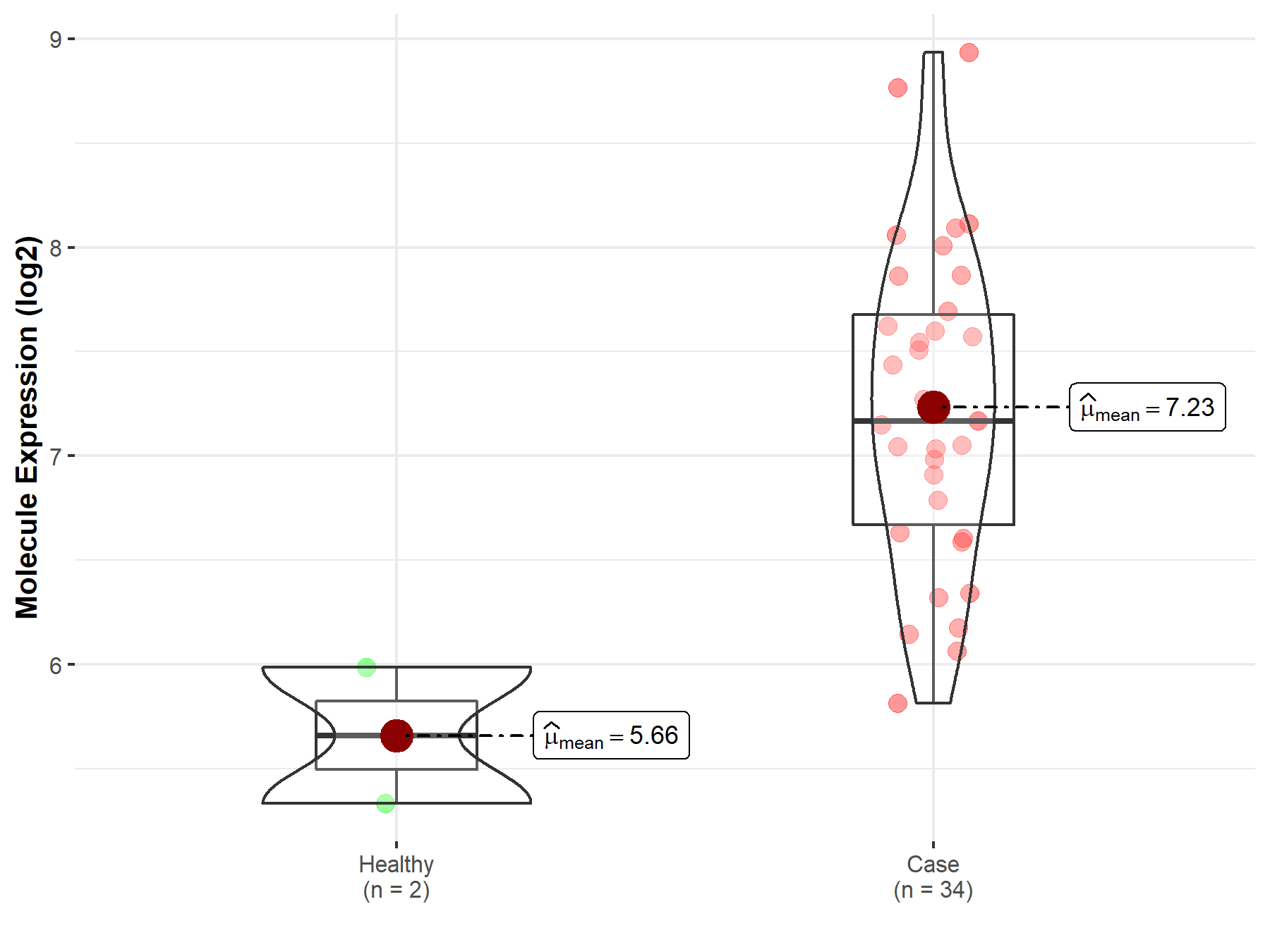
|
Click to View the Clearer Original Diagram |
| The Studied Tissue | White matter | |
| The Specified Disease | Glioma | |
| The Expression Level of Disease Section Compare with the Healthy Individual Tissue | p-value: 2.77E-03; Fold-change: 7.74E-01; Z-score: 8.28E-01 | |
|
Molecule expression in the diseased tissue of patients
Molecule expression in the normal tissue of healthy individuals
|
||
| Disease-specific Molecule Abundances |
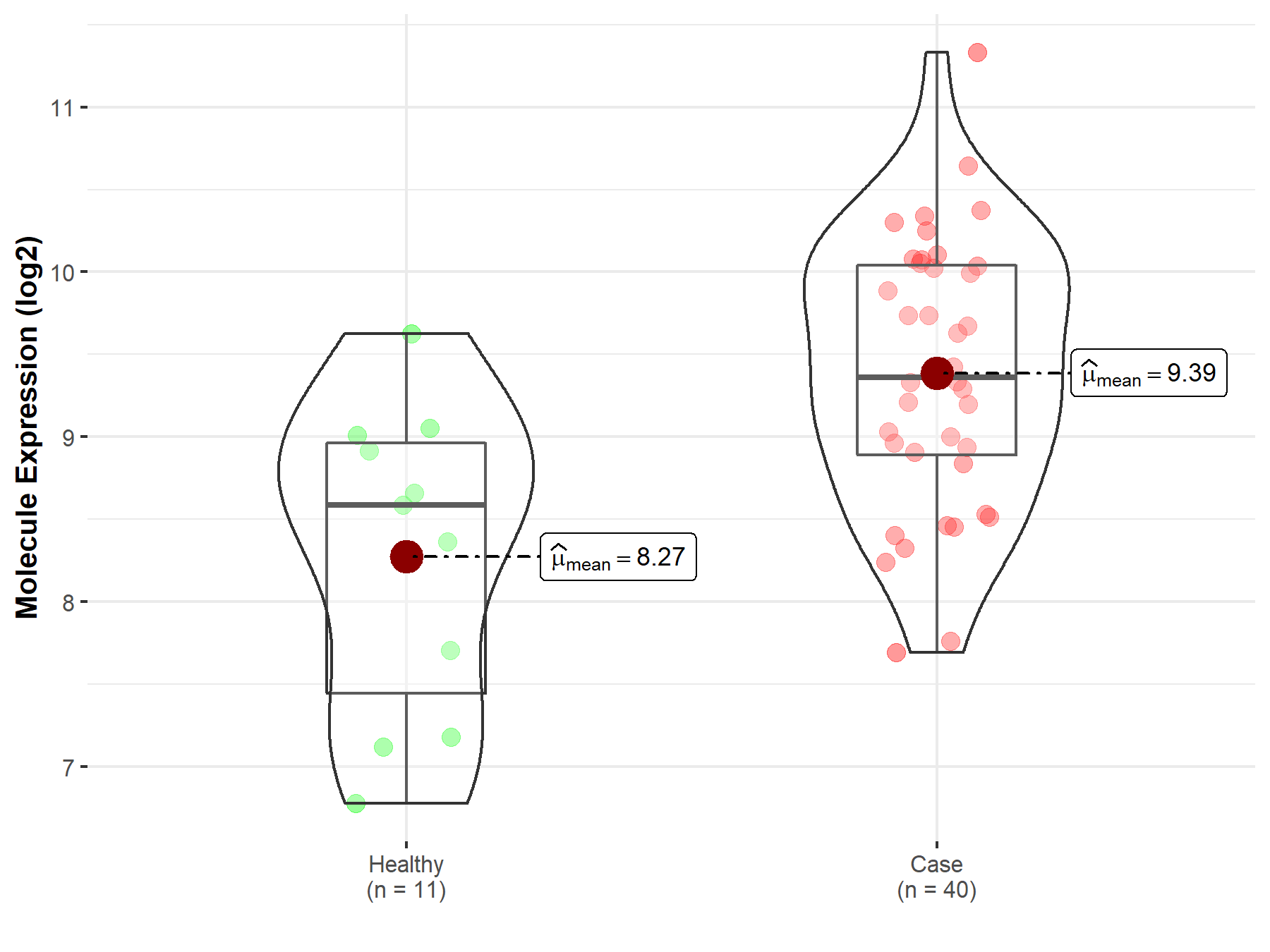
|
Click to View the Clearer Original Diagram |
| The Studied Tissue | Brainstem tissue | |
| The Specified Disease | Neuroectodermal tumor | |
| The Expression Level of Disease Section Compare with the Healthy Individual Tissue | p-value: 2.82E-09; Fold-change: 2.88E+00; Z-score: 5.50E+00 | |
|
Molecule expression in the diseased tissue of patients
Molecule expression in the normal tissue of healthy individuals
|
||
| Disease-specific Molecule Abundances |
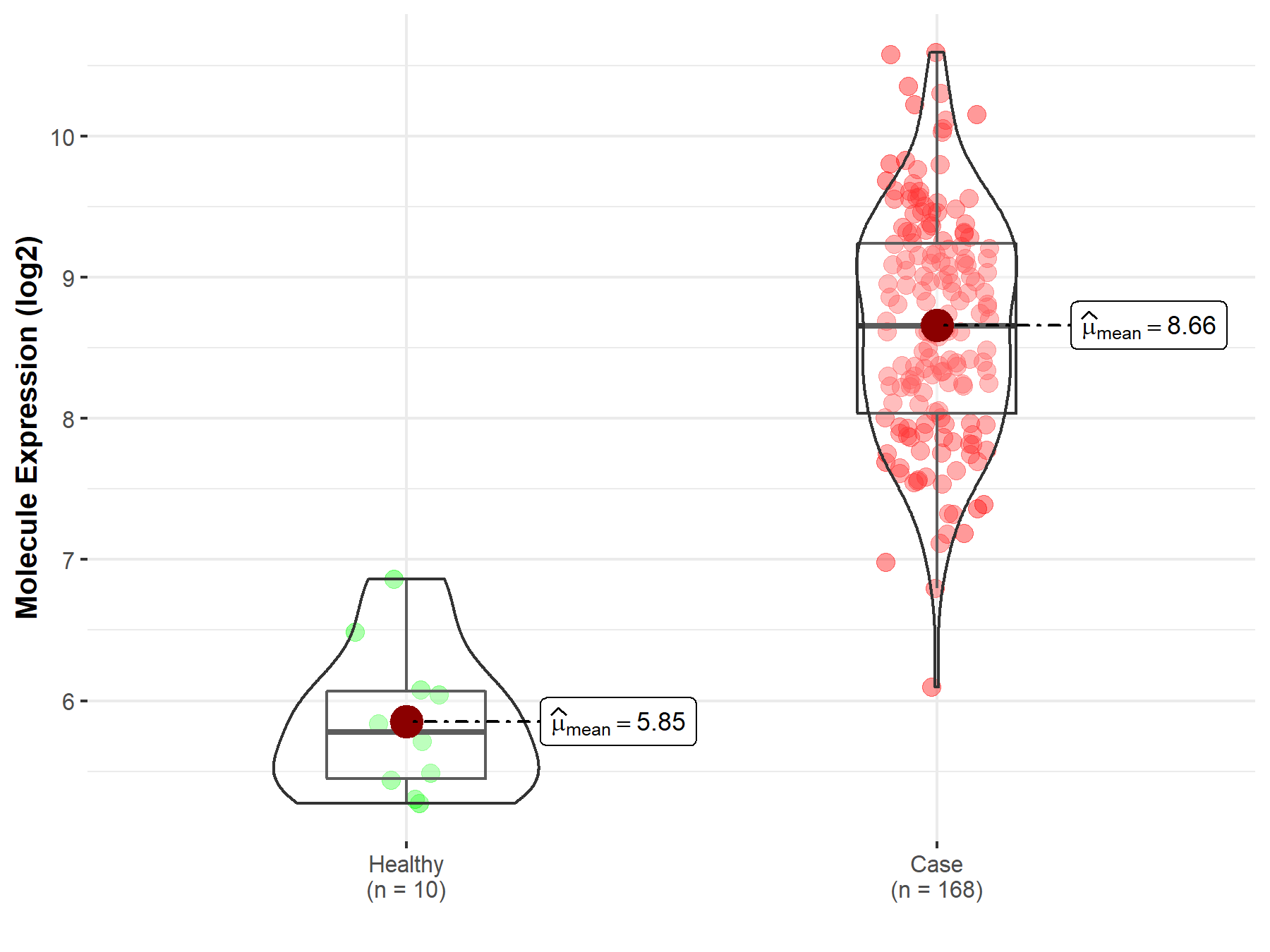
|
Click to View the Clearer Original Diagram |
| Differential expression of molecule in resistant diseases | ||
| The Studied Tissue | Colon | |
| The Specified Disease | Colon cancer | |
| The Expression Level of Disease Section Compare with the Healthy Individual Tissue | p-value: 4.92E-41; Fold-change: 5.36E-01; Z-score: 1.39E+00 | |
| The Expression Level of Disease Section Compare with the Adjacent Tissue | p-value: 1.47E-31; Fold-change: 6.65E-01; Z-score: 1.37E+00 | |
|
Molecule expression in the normal tissue adjacent to the diseased tissue of patients
Molecule expression in the diseased tissue of patients
Molecule expression in the normal tissue of healthy individuals
|
||
| Disease-specific Molecule Abundances |
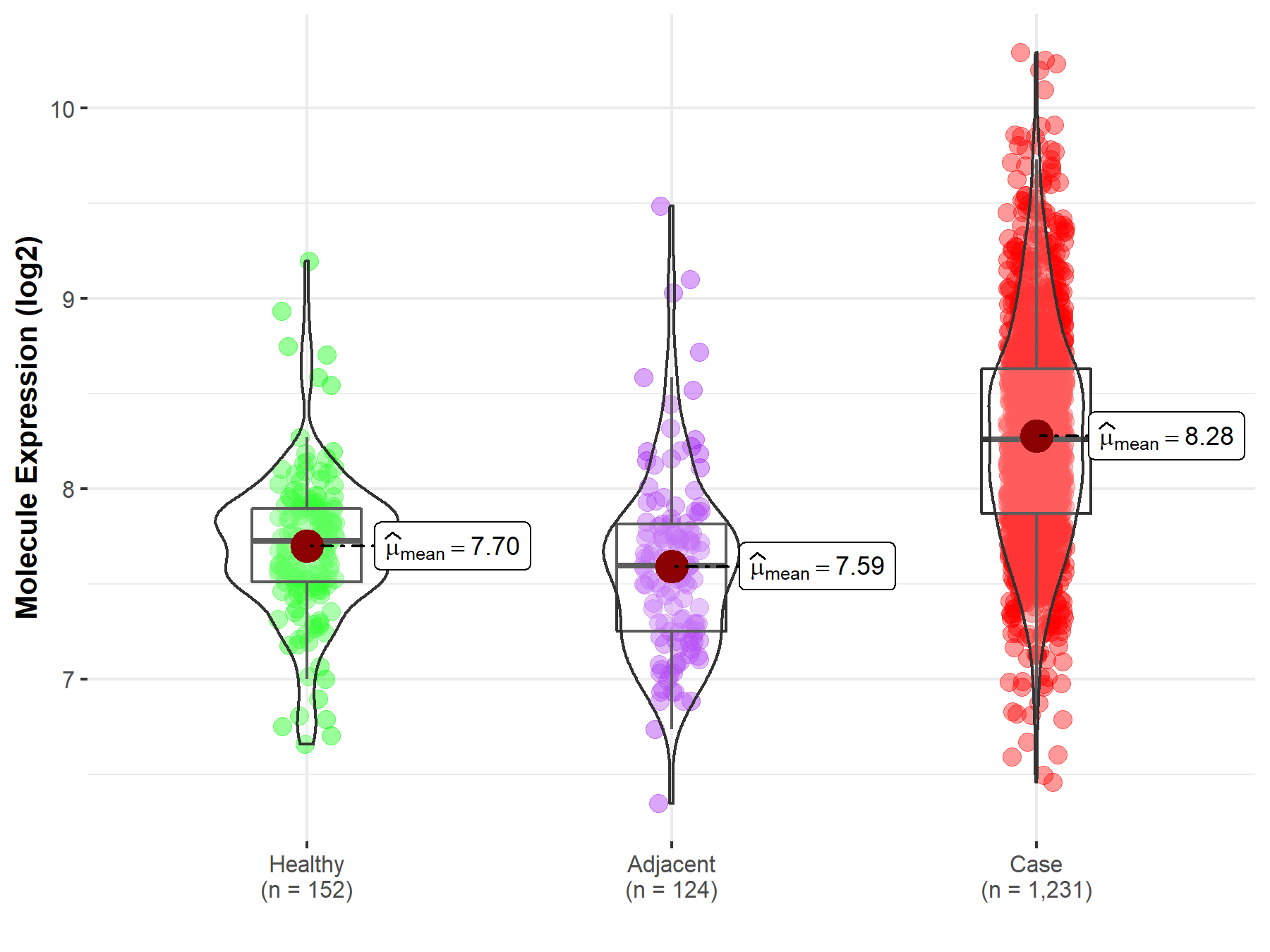
|
Click to View the Clearer Original Diagram |
| Differential expression of molecule in resistant diseases | ||
| The Studied Tissue | Skin | |
| The Specified Disease | Skin squamous cell carcinoma | |
| The Expression Level of Disease Section Compare with the Healthy Individual Tissue | p-value: 6.50E-11; Fold-change: -3.83E-01; Z-score: -6.73E-01 | |
| The Expression Level of Disease Section Compare with the Adjacent Tissue | p-value: 8.08E-14; Fold-change: -6.15E-01; Z-score: -8.53E-01 | |
|
Molecule expression in the normal tissue adjacent to the diseased tissue of patients
Molecule expression in the diseased tissue of patients
Molecule expression in the normal tissue of healthy individuals
|
||
| Disease-specific Molecule Abundances |
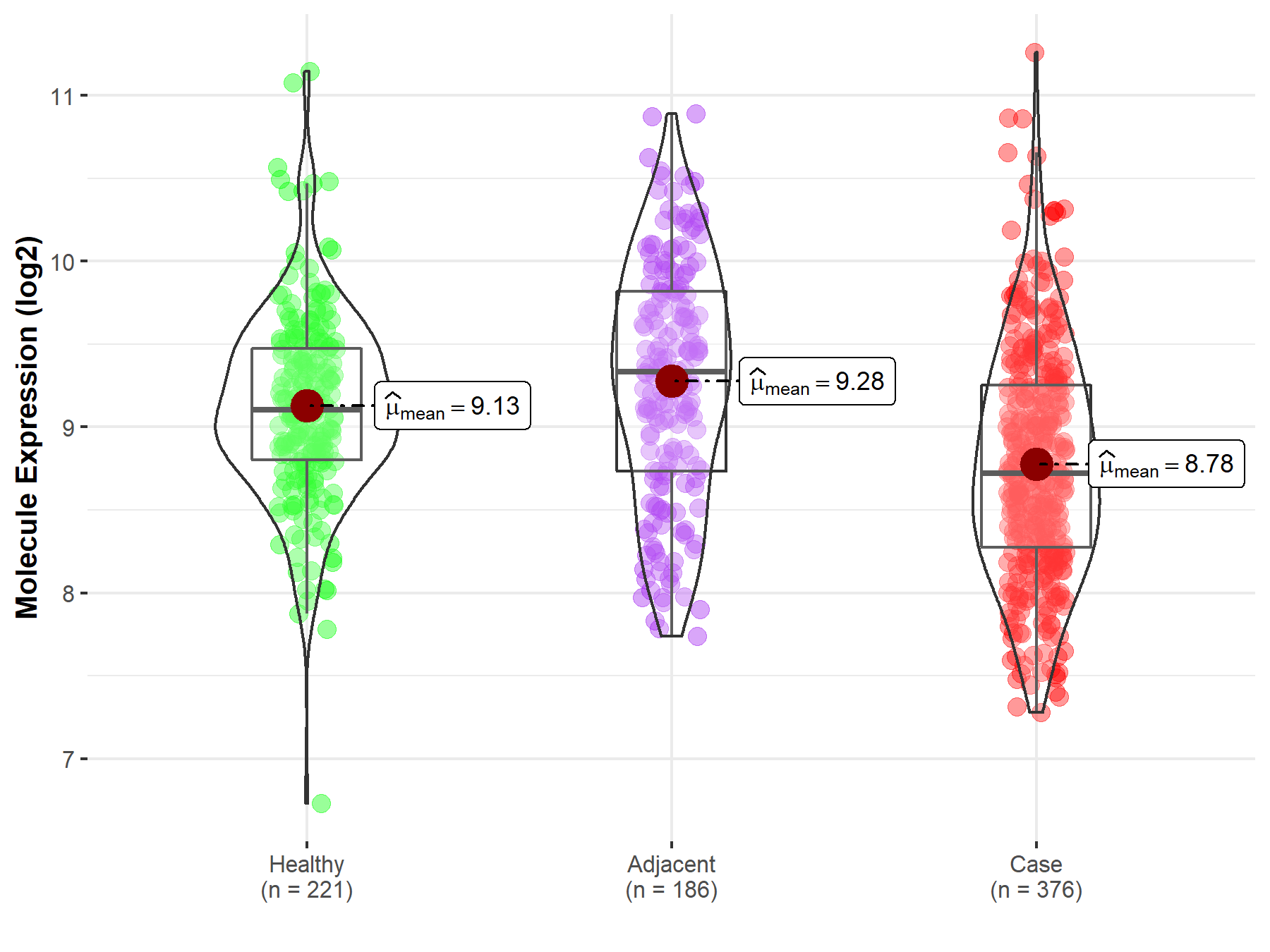
|
Click to View the Clearer Original Diagram |
| Differential expression of molecule in resistant diseases | ||
| The Studied Tissue | Breast tissue | |
| The Specified Disease | Breast cancer | |
| The Expression Level of Disease Section Compare with the Healthy Individual Tissue | p-value: 1.38E-02; Fold-change: 1.14E-01; Z-score: 1.30E-01 | |
| The Expression Level of Disease Section Compare with the Adjacent Tissue | p-value: 2.79E-01; Fold-change: -2.69E-01; Z-score: -2.33E-01 | |
|
Molecule expression in the normal tissue adjacent to the diseased tissue of patients
Molecule expression in the diseased tissue of patients
Molecule expression in the normal tissue of healthy individuals
|
||
| Disease-specific Molecule Abundances |
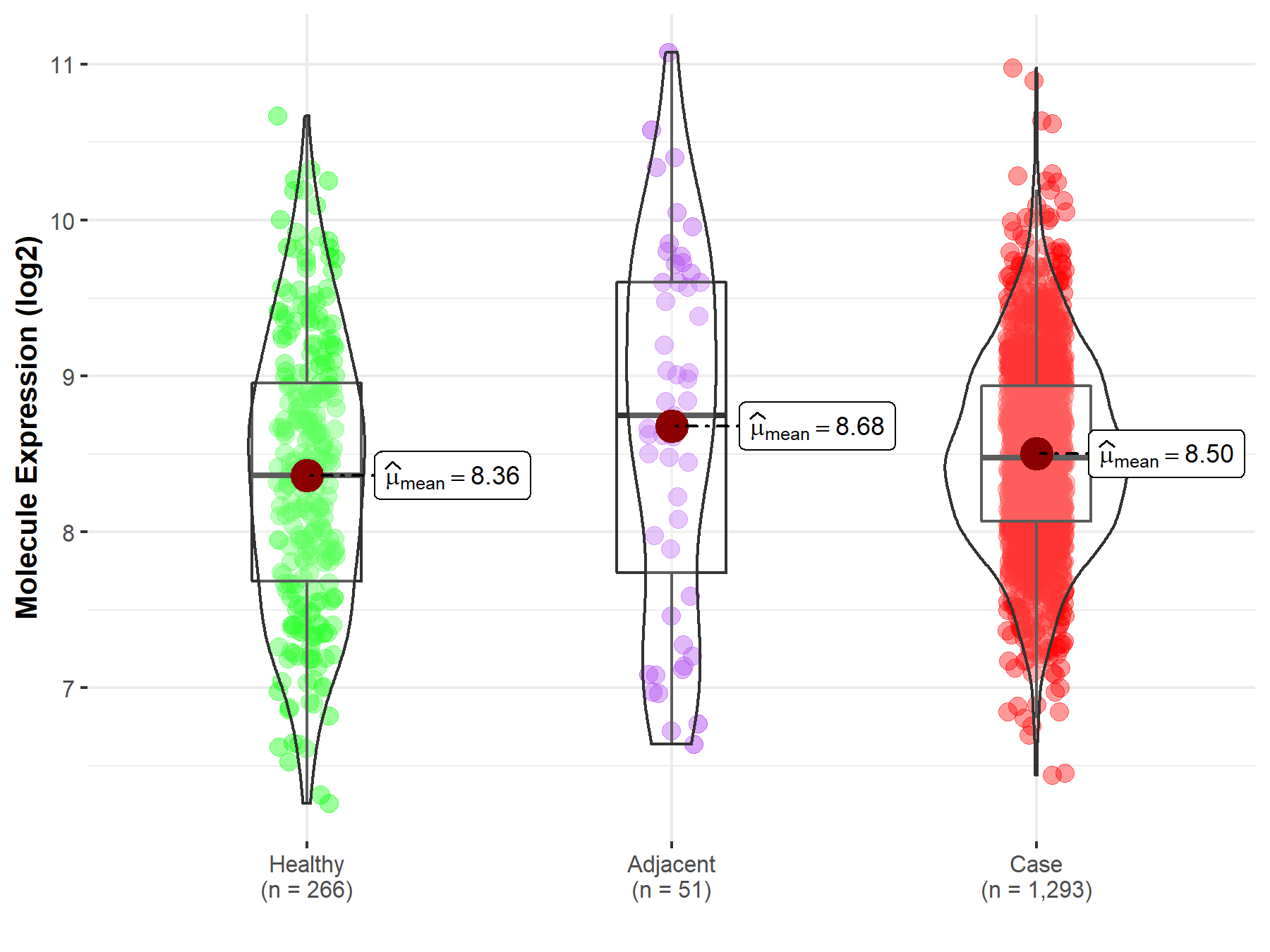
|
Click to View the Clearer Original Diagram |
| Differential expression of molecule in resistant diseases | ||
| The Studied Tissue | Kidney | |
| The Specified Disease | Kidney cancer | |
| The Expression Level of Disease Section Compare with the Healthy Individual Tissue | p-value: 5.46E-01; Fold-change: 2.80E-01; Z-score: 3.17E-01 | |
| The Expression Level of Disease Section Compare with the Adjacent Tissue | p-value: 3.65E-04; Fold-change: 1.96E-01; Z-score: 3.19E-01 | |
|
Molecule expression in the normal tissue adjacent to the diseased tissue of patients
Molecule expression in the diseased tissue of patients
Molecule expression in the normal tissue of healthy individuals
|
||
| Disease-specific Molecule Abundances |
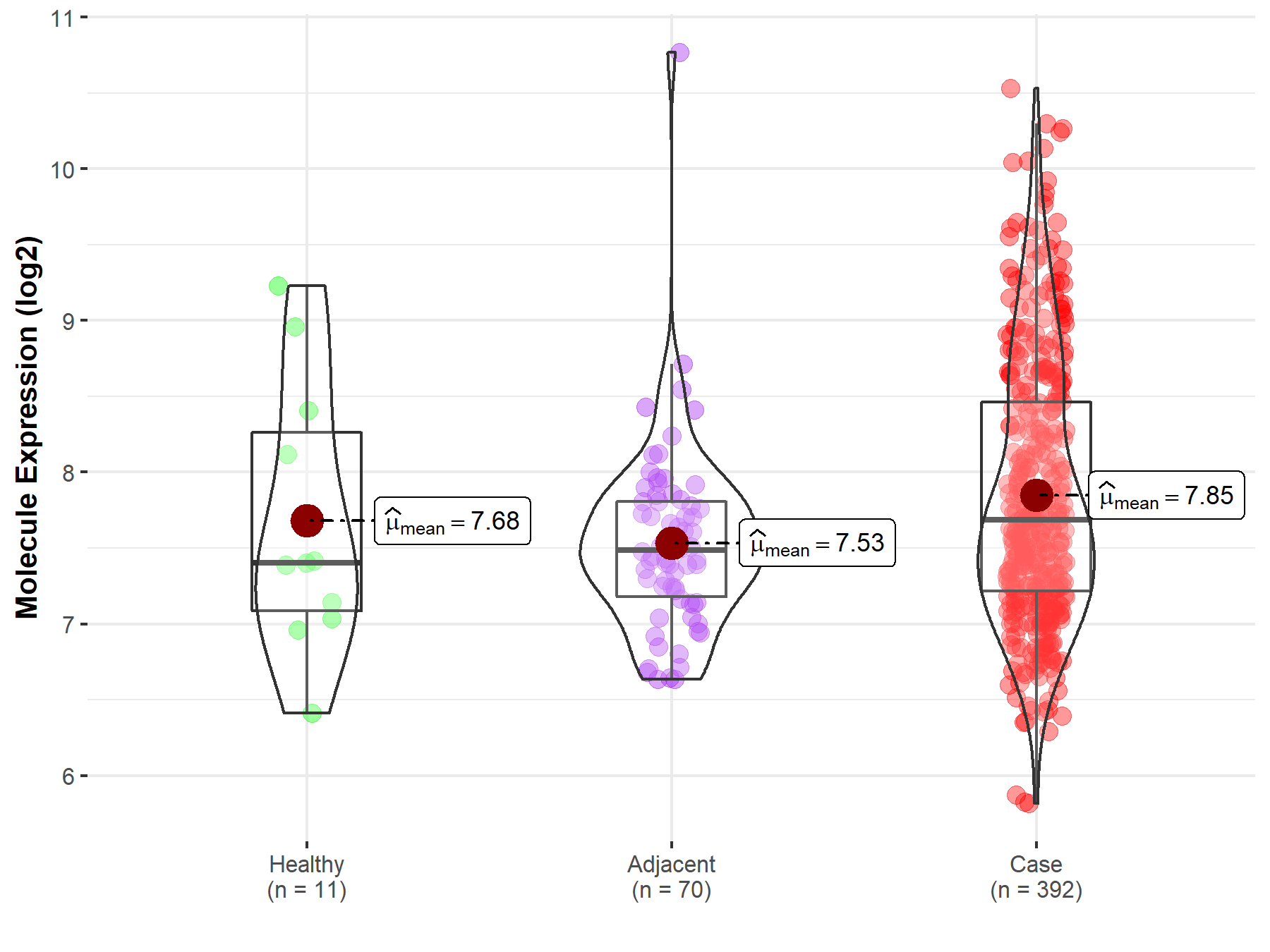
|
Click to View the Clearer Original Diagram |
Tissue-specific Molecule Abundances in Healthy Individuals

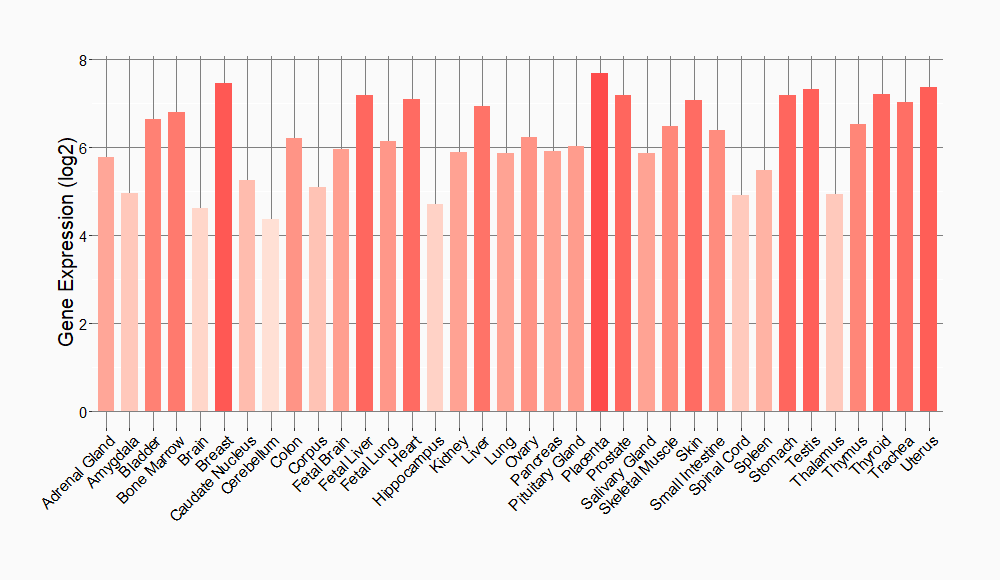
|
||
References
If you find any error in data or bug in web service, please kindly report it to Dr. Sun and Dr. Zhang.
